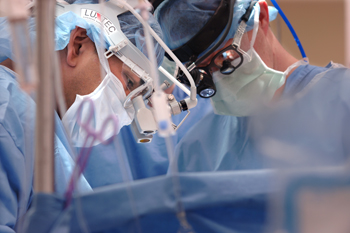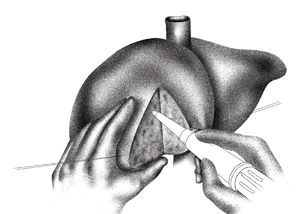
Ravi Chari, M.D., left, guides Surgery resident Eric Grogan, M.D., during a liver resection.
photo by Anne Rayner
Liver transplant program renews living-donor option

Living-donor liver transplantation involves removing, or resecting, a portion of a healthy donor’s liver and transplanting it to the patient.
Illustration by Dominic Doyle
Vanderbilt University Medical Center is reintroducing its living-donor liver transplantation program for adults.
The move is in response to the continued shortage of cadaver livers, combined with the growing number of patients qualified for transplant through a new donor allocation system developed by the United Network for Organ Sharing (UNOS).
“Despite the efforts to increase organ donation, the availability of cadaver donor organs has reached a plateau,” said Ravi Chari, M.D., chief of Liver Transplant and Hepatobiliary Surgery. “It is apparent that additional patients' needs can only be addressed with the living-donor contingency.
“We are restarting our program because of the ongoing shortage of organs. It is an important addition to our already excellent program and offers patients an alternative to waiting for a cadaveric graft. With our experience in both liver resection and transplantation, we are able to offer this option to our patients.”
Although this form of transplantation is often used in pediatric cases (such as parent-to-child), the adult-to-adult scenario has been much slower to develop. This is because the adult-to-adult donor operation is much larger, with increased chances for post-operative complications in the donor.
The Medical Center's last living-donor liver transplant was in 2001, six months prior to the implementation of the new allocation regulations.
As the wait times for suitable organs increase, more and more patients are dying before a new organ can be found. At Vanderbilt there are 242 patients waiting for liver transplantation.
There are only two liver transplant programs operating in the state, so with the addition of the living-donor option, Vanderbilt's liver transplant program is expected to be able to meet an already critical need.
Chari cautions that although there are many patients with specific diseases and special circumstances that make it important to proceed with liver transplantation sooner than a cadaver organ is available, not every patient can opt for the living-donor transplantation.
“Not only does the donor have to have the same blood type as the recipient and be of similar size in height and weight, but there must also be an established relationship with the patient,” he said.
Recipients are first evaluated for transplantation using the UNOS/OPTN scoring based on a calculated formula from three lab tests — bilirubin (which measures how effectively the liver excretes bile), INR (measures the liver's ability to make blood clotting factors) and creatinine (measures kidney function, which is associated with severe liver disease).
The score known as the Model for End-Stage Liver Disease (MELD) ranges from 6 (less ill) to 40 (severely ill) and is the basis for the placement on the transplant waiting list. The MELD scoring replaced the previous Status 2A, 2B and 3 categories. Status 1 remains the highest priority for receiving an organ; these patients have acute liver failure and are not expected to live more than seven days without a transplant.
While living donation liver transplantation eliminates the need to be on the waiting list, it is not a good option for those with high MELD scores or Status 1 listing, because in those who are so ill, the smaller piece of liver is overwhelmed and does not provide an adequate level of function.
“It is challenging,” said Chari. “The procedure itself is technically difficult, and what is of utmost concern is the donor. Preserving the donor's health and welfare is our top priority. You are taking a person who is in good health and putting them at risk.”
In order to ensure the safety of the donor, UNOS has issued program guidelines for those institutions interested in the living-donor option.
“The program must meet specific criteria set forth by UNOS in order to perform this kind of transplant. These guidelines were recently put in place to ensure that all programs have the appropriate personnel who are properly trained and credentialed, adequate surgical support and experience and available institutional resources, including data management and administrative collaboration.
“From a surgical standpoint, at Vanderbilt, our program is based on organ (liver) specific expertise, which was the vision of C. Wright Pinson, (M.D., director of the Transplant Center).
“At many other institutions, the surgical staff is separated between those who perform abdominal transplantation and those who do liver resections. Not all programs have surgeons with resection skills — we have these skills, as we all perform a large volume of liver resection procedures in addition to liver transplantation.”
Chari is pleased that long-time liver transplant coordinator Jerita Payne, a nurse practitioner, will coordinate the donor evaluation phase of the program.
Vanderbilt recently recruited two new members to its surgical team — Burnett “Beau” Kelly, M.D., who will serve as the surgical director of the pediatric liver transplant program and the adult living donor liver transplant program. Kelly comes to Vanderbilt from UCLA. Also new to the program will be Sunil Geeverghese, M.D., also from UCLA. He was a former surgical resident at VUMC and a VUSM graduate.
Other members of the team include Pinson; Kelly Wright, M.D., director of the Liver Transplant Program; and Lee Gordon, M.D., assistant professor of Surgery.
“We will all be involved in this new program,” Chari said. “The addition of Beau and Sunil will add to our manpower, and facilitate our ability to perform these resource-intensive procedures.”
The program is expected to have final UNOS approval by late spring, with the pediatric program following in the fall.
Reinstatement of this program required a “high level of institutional commitment,” said Chari.
“Last year, we worked closely with Norman Urmy and Warren Beck in hospital administration to ensure we did this the right way.”













